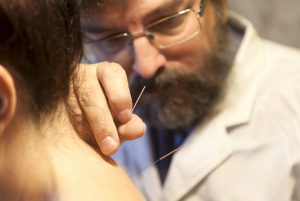 Western medical acupuncture is a therapeutic modality involving the insertion of fine needles. It is an adaptation of Chinese acupuncture using current knowledge of anatomy, physiology and pathology, and the principles of evidence based medicine.
Western medical acupuncture is a therapeutic modality involving the insertion of fine needles. It is an adaptation of Chinese acupuncture using current knowledge of anatomy, physiology and pathology, and the principles of evidence based medicine.
It acts by stimulating the nervous system, and is mainly used to treat musculoskeletal pain but is also effective for post-operative pain and nausea.
What’s the difference between Western and traditional Chinese acupuncture?
While Western medical acupuncture has evolved from traditional Chinese techniques, its practitioners no longer adhere to concepts such as Yin/Yang and circulation of qi, and regard acupuncture as part of conventional medicine rather than a complete “alternative medical system”.
Traditional Chinese acupuncture is based on the belief that it can restore the flow of Qi, an ‘energy’ that flows through your body, while western medical acupuncture is evidence-based and is only administered after a full diagnosis. The western model uses anatomy, physiology and current medical models.
Which of our practitioners can treat using acupuncture as part of a physical therapy treatment programme?
Simon Chafer is qualified to provide Western Medial Acupuncture as part of an osteopathy treatment plan. Please book a regular physiotherapy/osteopathy assessment and let the practitioner know that you are interested in a Dry Needling / Acupuncture treatment.


